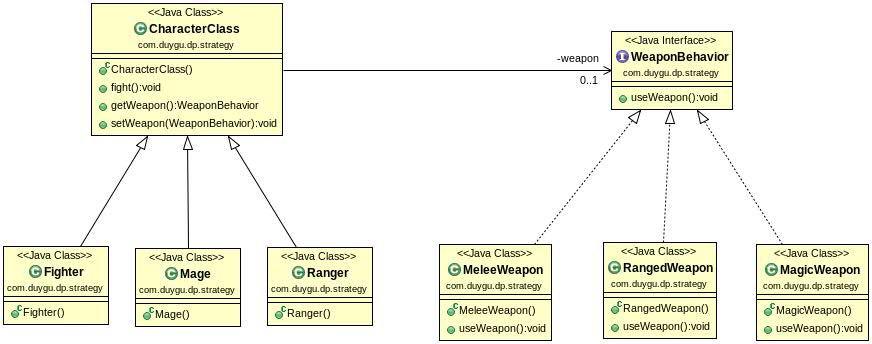12 Jun 2016
Talking about code, describing it without common vocabulary is hard. Writing code not knowing optimal way, figuring out the optimal way on the fly, or after it was too late is hard. So overcome this I started reading Head First Design Patterns. I will be posting the lines I highlighted during reading and implementing an example for the pattern I read.
-
Design Principle: Identify the aspects of your application that vary and separate them from what stays the same.
-
Take the parts that vary and encapsulate them, so that later you an alter or extend the parts that vary without affecting those that don’t.
-
All patterns provide a way to let some part of a system vary independently of all other parts.
-
We know we want to assign behaviors to the instances.
-
Design Principle: Program to a interface, not an implementation.
-
“Program to an interface” really means “Program to a supertype.” which means “the declared type of the variables should be a supertype, usually an abstract class or interface, so that the objects assigned to those variables can be of any concrete implementation of the supertype, which means the class declaring them doesn’t have to know about the actual object types!”
-
Use an interface to represent each behavior.
-
Each implementation of a behavior will implement one of those interfaces.
-
Design Principle: Favor composition over inheritance.
-
Creating systems using composition gives you a lot more flexibility. It lets you change behavior at runtime.
-
The Strategy Pattern defines a family of algorithms, encapsulates each one, and makes them interchangeable. Strategy lets the algorithm vary independently from clients that use it.
As an example for the strategy pattern, I implemented rpg characters weapon usage as a behavior.

My implementation: https://github.com/duyguserbest/design-patterns/tree/master/strategy
29 Apr 2016
Installation guide for distributed HBase with Zookeeper(which is a requirement for HBase, is being managed by HBase itself.).
Prerequisites:
Hadoop must be installed successfully.
Installation:
Do everything listed below for every instance which is a node on hdfs network, you want to run HBase on.
- Create a directory and navigate to created directory.
- Change folder’s owner if needed:
- sudo chown -R hadoop:hadoop hbase/
- cd hbase
- Download hbase-0.94.12 to current directory.
- wget “https://archive.apache.org/dist/hbase/hbase-0.94.12/hbase-0.94.12.tar.gz”
- Extract hbase files to current directory.
- tar -xvzf hbase-0.94.12.tar.gz
- Navigate to extracted directory.
- Edit hbase-site.xml using vim and set proper values to configuration properties.
- Edit regionservers file and list all hosts that you would have running Zookeeper.
- vim regionservers
- server30
server31
server32
server33
- Add HBASE_HOME environment variable to bashrc.
- vim ~/.bashrc
- export HBASE_HOME=/opt/hbase/hbase-0.94.12
- export PATH=$PATH:$HADOOP_HOME/bin:$HBASE_HOME/bin:$JAVA_HOME/bin
- To test if variable is added successfully
- Logout from user session:
- Log back in:
- Echo environment variable:
- Edit hbase-env.sh, uncomment and set proper values to properties.
- export JAVA_HOME=/usr/lib/jvm/java-8-oracle
- export HBASE_HEAPSIZE=4096
- export HBASE_MANAGES_ZK=true
- Symlink hdfs-site.xml under ${HBASE_HOME}/conf.
- ln -sv /opt/hadoop/hadoop-1.0.4/conf/hdfs-site.xml hdfs-site.xml
- Create HBase temp directory and Zookeeper data directory stated on hbase-site.xml.
hbase-site.xml:
Starting HBase:
To start HBase run “./bin/start-hbase.sh” on “/opt/hbase/hbase-0.94.12” directory. The instance you have run the starter script becomes the master of the network. You must start Hadoop’s DFS and Map-Red frameworks before running this command.
Testing Installation:
Checking if HBase initialised successfully:
Run “jps” on terminal and check if “HQuorumPeer” and “HRegionServer” processes running for every instance in your HBase network. When you run “jps” command on master you should also see the master process named “HMaster”.
Running hbase check:
When you run “hbase hbck”, there must be no inconsistencies detected. If an inconsistency has been detected, run “hbase hbck -repair” and/or “hbase hbck -fix” for easy fix.
Checking HBase Shell:
If HBase initialised successfully, you should be able to run “hbase shell” command to access tables. After running “hbase shell” if you come across
java.lang.RuntimeException: java.lang.UnsatisfiedLinkError: /tmp/jffi3876542469706275102.tmp: /tmp/jffi3876542469706275102.tmp: failed to map segment from shared object: Operation not permitted
this exception then this means you can “not execute” on your /tmp directory. This can mean that your company security policy block execution on tmp directory. To solve this problem you have two options: first one is giving execution permission on tmp to users, or changing java tmp directory by setting a parameter.
To solve the problem by changing java tmp directory:
1. Create a new directory where the user you started HBase with has execution permission.
2. Add -Djava.io.tmpdir parameter to HBASE_OPTS environment variable on hbase-env.sh.
3. export HBASE_OPTS=”-Djava.io.tmpdir=/work/hbase/hbase-java-temp -XX:+UseConcMarkSweepGC”
4. Restart HBase.
Stopping HBase:
Run “./bin/stop-hbase.sh” on “/opt/hbase/hbase-0.94.12” directory.
25 Apr 2016
Hello World!
This is my first post on this site so this should be a welcoming one.
I studied Computer Engineering for 4 years and have been working on a software company as a Software Engineer since 2014. In this blog I will talk about technologies, frameworks I learnt, I want to learn and how things should be.
I created this blog to be able to look up the solutions I came up with to a specific problems I faced, to remember how I installed softwares I used and what tools I used to solve general problems. Basically this blog is going to consist of the documentation of things I have done.
My first goal about this blog is writing posts for technologies, frameworks etc. I learnt in the past six years. This includes Java, Maven, Git, SVN, Hadoop, MongoDB, HBase, Python etc.
I hope my posts helps you as much as they helped me.
